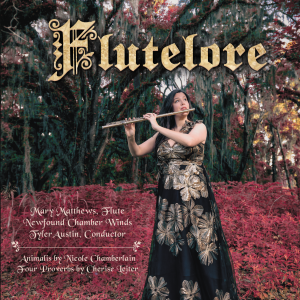
Artist
Mary Matthews – Flutelore
Big Blue Records
FLUTELORE from flutist Mary Matthews and the Newfound Chamber Winds invites listeners to embark on a journey of folklore, fairytale, and proverb inspired by the flute.
Commissioned by Mary Matthews in 2024, the flute concerti Four Proverbs by Cherise Leiter and Animalis by Nicole Chamberlain explore the comical to the spiritual capabilities of the flute.
Leiter’s concerto includes four movements inspired by proverbs from Kabir, Ida Outhwaite, Rumi, and traditional Latin proverb. She expands the traditional and expected sound world of the flute concerto and the wind ensemble by including alto flute, finger cymbals, shakers, body percussion, glockenspiel, and spoken text performed by the soloist and ensemble members.
Chamberlain’s concerto Animalis is composed in three movements, each exploring a fairytale or fable in which the flute calls, charms, or warns animals away from danger. The work makes brilliant use of extended techniques in the solo flute part and wind ensemble to depict underwater scenes, dramatic chases, and conversations between animals.
Four Proverbs, a concerto for flute and chamber ensemble by Cherise Leiter, was commissioned by Dr. Mary Matthews and is inspired by a collection of quotes about the flute. Each of the four movements is based on a different proverb or quotation, drawing from diverse cultural and literary traditions. The first movement is inspired by the Latin proverb: “All flute players are mad. When once they begin to blow, away goes reason.” This movement challenges the flutist to showcase a wide array of extended techniques, including jet whistles, overblowing through the harmonic series, singing while playing, and stomping and yelling in highly syncopated rhythmic patterns. In addition to performing on their instruments, the members of the ensemble also play shakers.
The second movement takes its inspiration from a quote by the Indian mystic poet Kabir: “The flute of the infinite is played without ceasing, and its sound is love.” It begins with the soloist on alto flute, accompanied by the ensemble humming. The movement transitions from a section in 7/4 time to a contrasting middle section in 12/4, performed on the C-flute, before returning to the opening material on the alto flute. The glockenspiel adds a shimmering texture to the ensemble.
The third movement is a lively rondo, alternating between a spirited 6/8 melody and two contrasting sections. This movement features only the higher instruments of the ensemble, accompanied by finger cymbals or triangle. The piece can be performed on either flute or piccolo, and is inspired by a passage from Fairyland, a book illustrated by Ida Rentoul Outhwaite with poems and stories by Annie Rentoul and Grenbry Outhwaite: “Then clear on a flute of purest gold, a sweet little fairy played. And wonderful fairy tales she told, and marvelous music made.”
The final movement draws on a quote from the Persian poet Rumi: “Play the flute of felicity! You, yourself, are the melody.” This movement stands apart from the others in that it does not incorporate additional percussion. It opens with a bold declamatory statement from the flute, then moves into a groove-based section characterized by rapid, running notes. As the movement progresses, fragments from previous themes reappear, leading to a joyful, celebratory conclusion.
Animalis, a concerto for flute and chamber winds by Nicole Chamberlain, was commissioned by Dr. Mary Matthews for the album Flutelore, in collaboration with the Newfound Chamber Winds, directed by Dr. Tyler Austin. The title Animalis, derived from the Latin word for “breath,” symbolizes the connection between the act of breathing and the life force of animals. The work explores flute and animal-centered stories and traditions passed down through generations, blending myth, fable, and fairytale in three distinctive movements.
The first movement, Calling Sheep, evokes the ancient practice of shepherds using flutes to guide and calm their flocks. The music reflects the peaceful yet purposeful nature of this pastoral ritual, with the flute acting as the shepherd and the ensemble responding with motives that resemble the calls of sheep.
The second movement, No Fish Were Charmed, is inspired by a Greek fable in which a fisherman attempts to enchant fish with the sound of his flute. When the fish fail to respond, he resorts to catching them and mocking their “dance.” The music begins with a light, playful character, but gradually darkens as the fisherman’s frustration leads to the fish’s ultimate demise.
The final movement, Wolf Pipe, is based on an Aesop fable in which a young goat is captured by a wolf, who plans to eat her. In a last-ditch effort to delay her fate, the goat convinces the wolf to play his pipe one final time. The familiar sound of the wolf’s music alerts the flock’s protective dogs, who rush to the goat’s rescue, sending the wolf into retreat. The movement gradually builds in intensity, culminating in a thrilling and dramatic chase.

